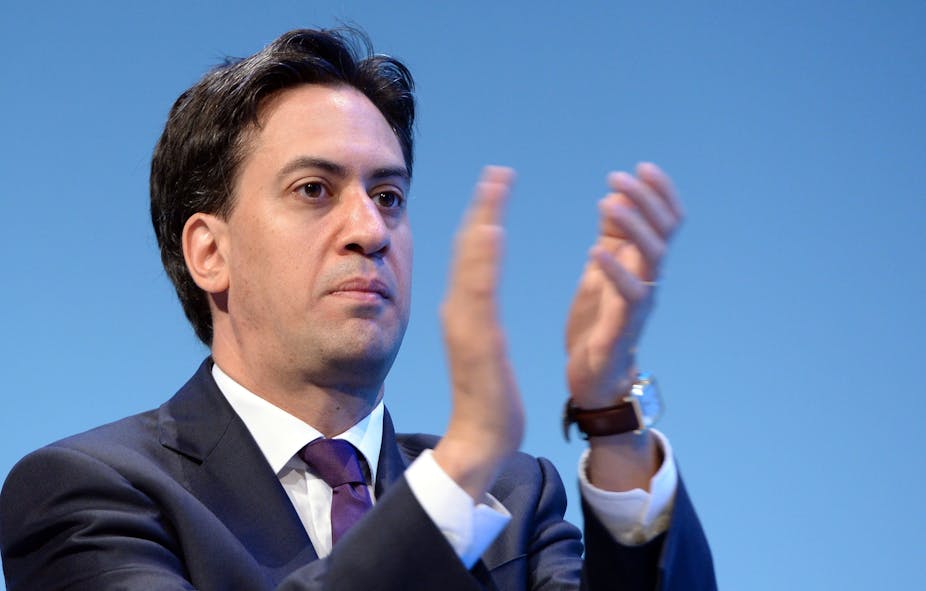In the wake of the ALP’s poor result in the recent Western Australia Senate election, The Conversation is publishing a series of articles looking at the party’s brand, organisation and future prospects.
In a post-industrial and neoliberal era, questions of identity are posing acute problems for political parties with ties to organised labour all over the world. Reflecting on the Australian Labor Party’s dismal showing in the Western Australian Senate by-election, former WA premier Geoff Gallop presciently asked of the ALP:
Is it a union-based party or is it a social democratic party?
This existential crisis about Labor and trade unions has been ongoing, and not just in Australia. But as federal Labor leader Bill Shorten seeks to reinvent his party, he will do well to examine the reforms his UK counterpart Ed Miliband has introduced to the Labour Party in Britain.
In Britain, the relationship between the unions and Labour has been fractious for a while. Since the 1990s, new “super-unions” have emerged. UNISON (formed in 1993) and Unite (formed in 2007) are the current big players.
In addition, there has been a new generation of left-leaning trade union leaders. The late Bob Crow, the former head of the National Union of Rail, Maritime and Transport Workers (the RMT), was perhaps the most prominent of these. Len McCluskey, who heads Unite, has made noises about severing the union’s historic link with Labour.
However, it was Unite’s activities that prompted the latest crisis between the unions and Labour. Unite was accused of vote-rigging in the Falkirk pre-selection, leading to further claims that McCluskey (and in turn Miliband himself) were elected with the help of “phantom” members.
In response, Miliband has led a fresh round of internal reform. At a special conference in March, he won party backing to reform the link with the unions.
The main reform is to move towards one-member one-vote (OMOV) for choosing the Labour leader. Currently, the party leader is elected through an electoral college: one-third of the vote from the unions, one-third from the parliamentary party, and one-third from party members.
Significantly, Miliband has backing to reform wider membership of the party. Trade union leaders remain under fire for exercising disproportionate influence over Labour: not all of their members vote Labour, but their numbers count in shaping policy and pre-selections. Under the new rules, affiliated trade union members will have to choose to become a supporter or member of the Labour Party.
Debate continues as to whether either Labour or the unions gain from these reforms. McCluskey and Unite have signalled that their donations to the party will drop dramatically. However, the number of individual union and party members could increase, bolstering Labour’s campaigning presence. That is a crucial factor in increasing voter turnout at elections.
These reforms build upon recent changes where Labour created a new category of “registered supporter” to increase involvement. In addition, Labour will move towards the greater use of primaries for pre-selections – starting with the 2016 London mayoral elections.
For Miliband, there is a dual pressure to both reformulate the link with the unions but also push for broader appeal. In Miliband’s words, the aim of the reforms is to “let people back into our politics”. However, the unions will still retain a 50% block vote at Labour’s party conference and also retain their quota on the party’s national executive.
Two wider issues frame this debate about Labour’s link with the unions. Structurally, trade union density is declining in both Britain and Australia, so there is pressure to reduce its bloc vote.
Politically, trade unions have been demonised and marginalised since the 1980s. In Britain, it started with Conservative prime minister Margaret Thatcher’s assault on what she called the “enemy within” – the trade unions.

The unions themselves have not always helped their cause. In the UK, the Falkirk episode is damaging. In Australia, corrupt behaviour in the Health Services Union and allegations of corrupt dealings in the Construction, Forestry, Mining and Energy Union fuel this antipathy.
As Labor historian Nick Dyrenfurth notes, these events have helped prime minister Tony Abbott wage a political campaign against both the unions and Labor. However, the (unfashionable) case for unions is still needed. As federal Labor MP Andrew Leigh notes in his book on equality, unions in Australia remain fundamental in the struggle against growing economic inequality.
Cut short by his mother’s passing, Shorten has yet to deliver his speech where he was to unveil his reform agenda. He has floated the idea of removing the requirement for party members to be trade union members, and reducing the fee to join the party to boost membership.
Shorten also reportedly favours reforming the way state leaders are elected, with a 50:50 vote between the parliamentary wing and the rank and file. Reports of the contents of the speech also suggest greater involvement for party members in the pre-selection process. Yet it remains unclear whether he will tackle the union bloc vote at party conferences, which is, in effect, their power to veto policy.
While the ALP might push to create party “supporters”, views are mixed about the growing use of primaries to pre-select candidates. Labor senator and factional powerbroker Kim Carr, in his Letter to Generation Next book, notes the low uptake at a trial of a primary election in Kilsyth before the Victorian state election in 2010.
The lessons from the UK are complex. Ultimately Shorten might resist Gallop’s assertion that the ALP is either labourist or social democratic. It is, and has always been, a mixture of a number of traditions.

